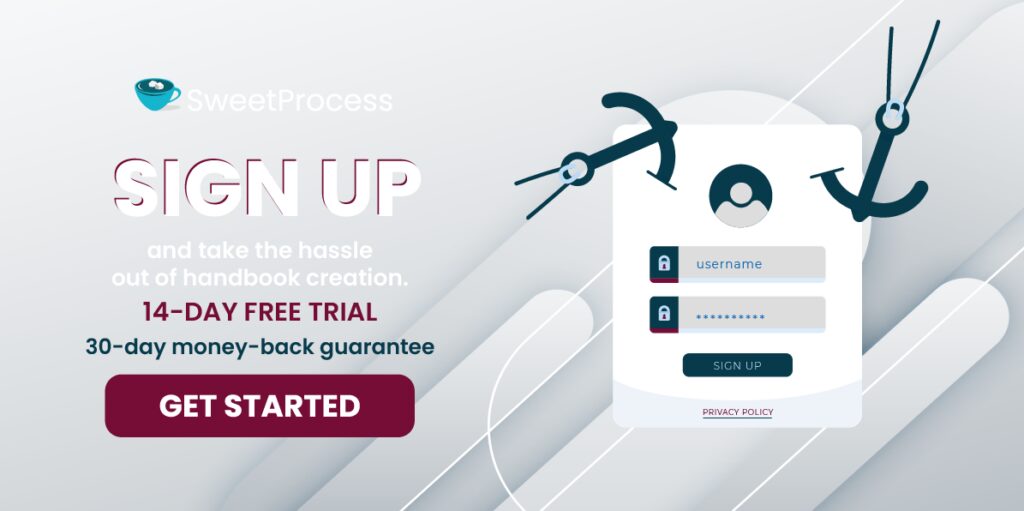Last Updated on April 28, 2025 by Owen McGab Enaohwo
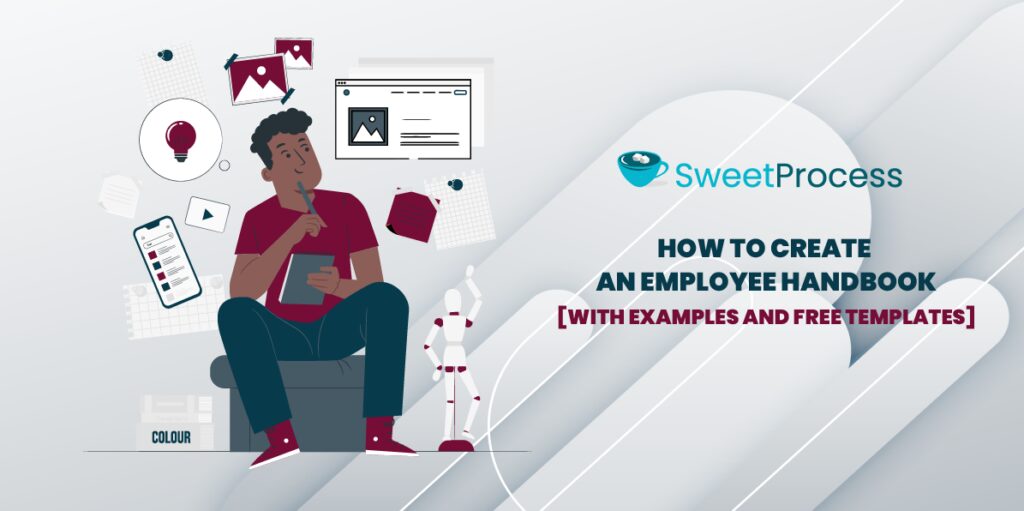
A modern-day business manager might be forgiven for thinking that physical employee handbooks are a relic of the past.
Everything a recruit might need is on the company website, and with so many people working from home, why would you ever need one?
But we wager the humble employee handbook still has a place in the modern office. Sure, it may not be legally needed. But it’s still a valuable piece that shows your company’s values and personality and provides something tangible your new team members can revise when the going gets tough. It can also help you spread the word about your company.
Here’s all you need to know about how to create an employee handbook from scratch.
Simplify your workflow with SweetProcess. Try out with our 14-day free trial.
Table of Contents
How to Create an Employee Handbook for Your Company in 8 Steps
What to Consider Including in Your Company’s Employee Handbook
How to Create and Manage Your Company’s Employee Handbook Using SweetProcess
6 Amazing Employee Handbook Examples You Can Copy
Benefits of an Employee Handbook in Your Company
Employee Handbook Tips and Best Practices
Free Employee Handbook Templates You Can Tweak and Use for Your Small Business
Create and Manage Your Company’s Employee Handbook Using SweetProcess
Frequently Asked Questions (FAQs) About Employee Handbooks
What Is an Employee Handbook?
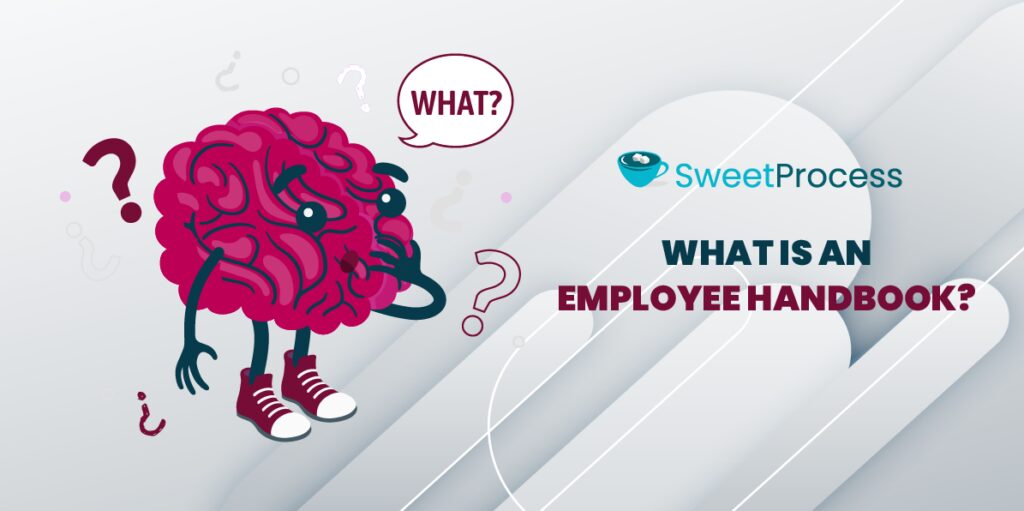
An employee handbook serves as a comprehensive guide outlining essential company policies, standard operating procedures (SOPs), and expectations for new hires. It summarizes the company’s core values, history, and mission, providing employees with a clear understanding of their roles and responsibilities. An employee handbook may also include HR forms, policies, program details, and procedures for specific situations, such as reimbursement processes.
Clarity is paramount; each policy, program, or procedure should be articulated straightforwardly, facilitating easy comprehension for all employees. For intricate policies, it is advisable to create separate documents with summarized versions in the handbook, along with pointers on where to access detailed information.
It’s important to note that an employee handbook is not an employment contract. Rather, it’s a record of what your organization is trying to accomplish, how it does so, and what is expected from the employees. Recognizing the dynamic nature of the workplace, the handbook remains a fluid document, subject to amendments and updates as necessitated by evolving organizational needs and regulatory requirements.
The benefits of a meticulously crafted handbook are manifold. In addition to serving as a tool for onboarding new employees, it establishes transparent expectations and mitigates potential conflicts by spelling out dos and don’ts.
Start your free 14-day trial with SweetProcess today!
While every company can figure out what to include in their handbooks, they typically include the following sections.
How to Create an Employee Handbook for Your Company in 8 Steps
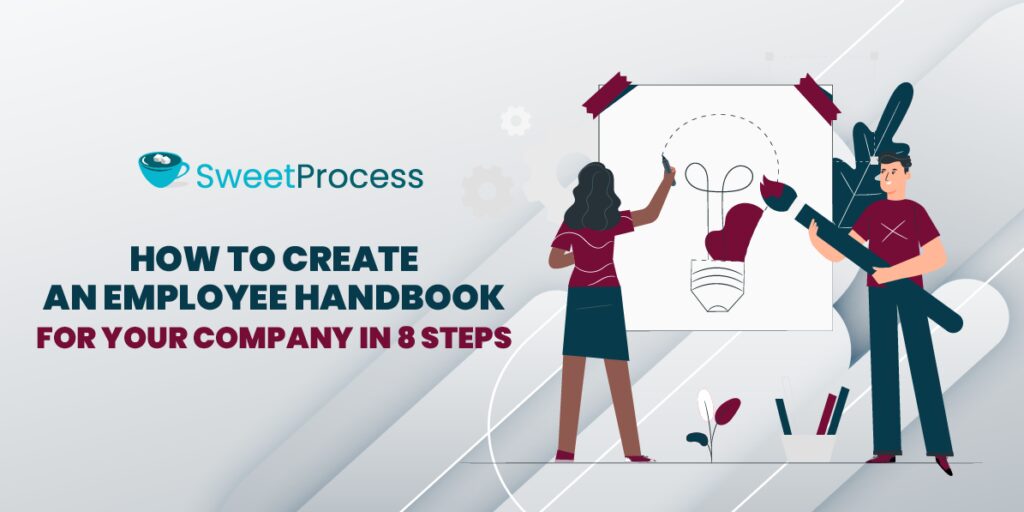
There are many ways to create an employee handbook. However, in our experience helping companies create and document their policies and procedures, all successful implementations share eight common steps.
Feel free to play with them to develop a procedure for creating, implementing, and updating your employee handbook. We’ve also included relevant questions you can ask yourself at each step of the process.
Step 1: Create an outline highlighting what to include in the employee handbook
Collect your company’s overarching policies, procedures, and information that must be included in the handbook. Consider questions such as:
- What are the essential policies and procedures relevant to our company’s operations?
- What legal requirements do we need to adhere to?
- Are there specific company values or cultural norms that should be addressed?
Step 2: Create summarized versions of each policy and procedure in the handbook
Condense each policy and SOP into clear, concise, easily understandable summaries for employees. Ask yourself:
- Can this policy be explained in a few sentences without losing its essence?
- Are there any complex legal terms or jargon that need to be simplified?
- Does the tone and voice of the content match what we’re trying to convey in the handbook?
Step 3: Add a statement summarizing the appropriate sections in the outline
Craft a brief statement summarizing the purpose and scope of each section outlined in the handbook. The statement acts as a quick summary of what the sections represent. Questions to consider here include:
- What overarching message or goal do we want to convey with each section?
- How can we ensure consistency and coherence throughout the handbook?
- Are there any sections that overlap?
Step 4: Build each section of the handbook
Now that you have your outline in place, build each section using the policy information you’ve collected. Ensure the sections adhere to your brand’s voice, mission, and values. Ask:
- Have all policies and procedures been accurately summarized?
- Are there any inconsistencies or contradictions between sections?
- Are there any deviations/contradictions from the company’s values/mission in any of the sections?
Step 5: Review and share the finalized version of the employee handbook with the legal department
Submit the completed handbook to the legal department for a comprehensive review to ensure legal compliance and mitigate potential risks. Consider:
- Are there any legal implications or liabilities associated with our policies and procedures?
- Do we need to make any adjustments to ensure compliance with relevant laws and regulations?
Step 6: Select a mode of publication

Determine how the handbook will be published and distributed to employees. While a physical copy is great, you can also send PDFs to their email. Consider options such as:
- Printing physical copies for distribution during employee onboarding sessions
- Publishing a digital version accessible through the company’s intranet or email system
Step 7: Distribute the handbook to employees
Disseminate the finalized handbook to all employees and ensure they understand its contents. Consider the following questions:
- Have all the employees been updated on receiving the handbook?
- Do we need orientation sessions to help employees understand the handbook?
- Are the distribution channels working and tested?
- What procedures do we have in place to test whether employees have reviewed the contents of the handbook?
Step 8: Update when necessary
Regularly review and update the handbook to reflect changes in company policies, procedures, or legal requirements. Ask:
- Are there any new laws or regulations that require updates to our policies?
- Have there been any changes to our company’s operations or culture that necessitate revisions to the handbook?
The steps above should help you get a basic outline in place. But crafting an employee handbook requires navigating challenges like legal compliance, relevance, and clarity. The document will need to strike a delicate balance between comprehensive detail and readability while remaining adaptable to future changes. Let’s take a closer look at the sort of sections you can include.
Sign up with SweetProcess and take the hassle out of handbook creation. 14-day free trial. 30-day money-back guarantee.
What to Consider Including in Your Company’s Employee Handbook
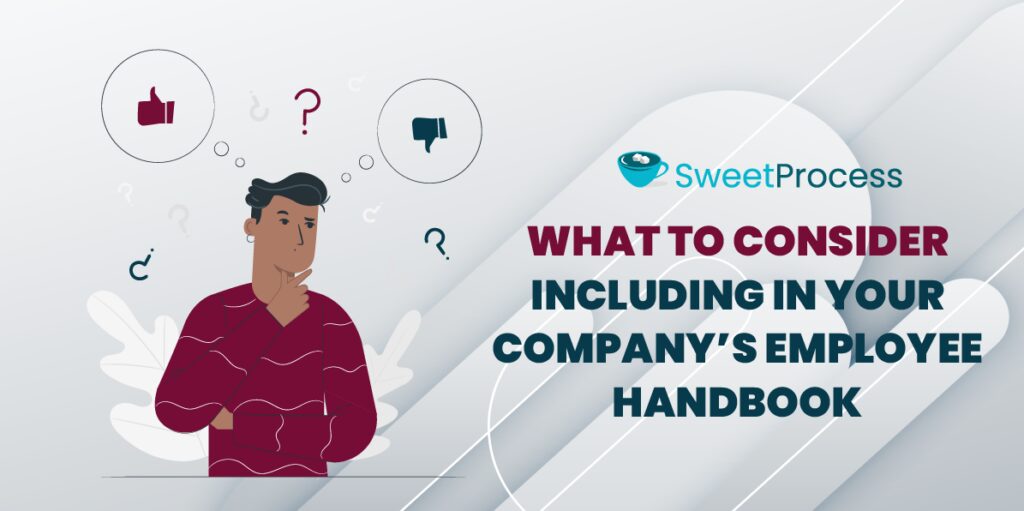
The employee handbook is the cornerstone of your company’s culture and operations. It’s more than just a collection of policies; it’s a roadmap for success and it reflects your values. This section provides an overview of what employees can expect in the handbook and sets the tone for their journey within the organization.
Company Mission, Vision, and Values
It’s important to remember that unlike your website and press releases, where you need to be succinct and professional, the employee handbook is something people outside your organization will never see.
This is also why the handbook is the perfect place to discuss your organization’s reason to be as detailed and expressive as possible. Feel free to discuss what your organization is trying to do and how it aims to achieve it. Consider asking:
- How can the mission, vision, and values be effectively communicated in the handbook?
- What examples or anecdotes can be included to illustrate how these principles are implemented?
Employment Basics
It is crucial to cover fundamental employment details such as employment status, eligibility criteria, and onboarding procedures. This section outlines the basic framework of employment within the company, ensuring clarity and consistency for all employees.
- What essential employment information should be included to address common employee queries?
- How can complex employment policies be simplified and communicated effectively?
Code of Conduct
Employee handbooks are easily your most useful tool for spelling out conduct expectations. This is because behavior is complex and contains several (gray area) nuances that may be hard to spell out legally.
You can start by providing a clear code of conduct that delineates acceptable behavior, including policies on punctuality, attendance, and respectful interactions with colleagues. Additionally, guidelines on the appropriate use of company resources, such as computers and equipment, can be included to promote responsible and ethical behavior among all employees.
- How can the code of conduct reflect the company’s values and culture?
- What procedures should be outlined for reporting violations or seeking guidance on ethical dilemmas?
Compensation, Benefits, and Perks
While compensation and benefits must be expressly stated in the contract, they can also be elaborated on in the employee handbook. It can include details on salary structures, bonus opportunities, and any additional incentives available.
Specific policies regarding paid holidays, sick leave, overtime, parental leave, remote work allowances, and paid vacation can be outlined, along with procedures for timekeeping and reporting.
- How can compensation and benefits information be presented in a comprehensive yet accessible manner?
- What resources or tools can help employees better understand their compensation and benefits options?
Working Hours, PTO, and Vacation

Clarifying policies related to working hours, paid time off (PTO), and vacation accruals ensures consistency and fairness. Employees also need clear guidelines on scheduling, requesting time off, and effectively managing their work-life balance.
- What procedures should be outlined for requesting and approving time off?
- How can the handbook address flexible work arrangements and remote work policies, if applicable?
Employee Resignation and Termination
Navigating employee departures with professionalism and respect is essential for maintaining morale and preserving the company’s reputation. This section outlines procedures for resignations, terminations, and exit interviews, emphasizing dignity and confidentiality.
- What steps should existing employees follow when resigning from their positions?
- How can the company ensure a smooth transition and protect sensitive information during employee terminations?
Anti-Harassment and Non-Discrimination Policy
This section highlights the company’s commitment to maintaining a diverse, inclusive, and respectful workplace environment. An anti-harassment policy is even more important if you have a remote team with people from different cultures.
Employees can be educated on the company’s policies prohibiting discrimination and harassment based on factors such as race, gender, religion, or sexual orientation.
Clear procedures for reporting and addressing any incidents of discrimination or harassment can be outlined to ensure all employees feel safe and supported in their work environment. Consider asking:
- How can the anti-harassment and non-discrimination policy be communicated effectively to all employees?
- What training or education initiatives can support the implementation of these policies?
Dress Code

Dress code policies aim to ensure a professional and consistent appearance across all levels of the organization. The employee handbook can include instructions on appropriate attire for various work settings, whether formal business attire or casual dress codes.
Specific requirements regarding uniforms, personal grooming, and accessories can be outlined to help maintain a polished and professional image reflective of the company’s brand. Questions to consider:
- How can the dress code policy balance professionalism with employee comfort and expression?
- What considerations should be made for different work environments or client-facing roles?
Communications Policy
Given the prevalence of digital communication today, this section will clarify the company’s policies on communication channels, including company-owned devices and social media use.
Employees will learn what types of communication are permitted during work hours, such as personal phone calls or social media usage, and any restrictions or guidelines regarding interactions with the media.
By understanding these protocols, current employees can ensure they represent the company appropriately and professionally in all communications. Ask:
- What protocols should be in place for using company communication tools and platforms?
- How can the communications policy support effective collaboration and information sharing among employees?
New Hire and Separation Procedures
Since the employee handbook will be the first document your new hires will see, it needs to land a good impression. This section should outline steps for welcoming new hires, conducting orientation, and managing employee exit professionally and respectfully.
Questions to ask here include:
- What resources or materials should be provided to new hires during the onboarding process?
- How can the company support departing employees and facilitate a smooth transition out of the organization?
Here’s how to create an employee offboarding checklist to prepare for exiting employees.
Reviews, Promotions, and Raises

This section should contain guidelines regarding how performance is evaluated, what factors are considered for advancement within the company, and the timeline for annual reviews. Additionally, employees will be introduced to the organization’s performance management system, if applicable, along with any tools or resources available to support their professional growth. Consider asking:
- How can the review process be structured to provide meaningful feedback and support employee growth?
- What criteria should be considered when evaluating employees for promotions or raises?
Compliance Policies
Staying compliant with legal and regulatory requirements is imperative for mitigating risk and maintaining integrity. This section outlines policies and procedures for ensuring compliance with relevant laws, industry standards, and company protocols.
- What legal and regulatory requirements apply to your industry, and how should they be addressed in the handbook?
- How can employees access resources better?
Employee Acknowledgment
Confirming employees’ understanding and acceptance of handbook policies is essential for accountability. This section outlines the process for employees to acknowledge receipt of the handbook and their commitment to complying with its contents.
- What methods can be used to collect employee acknowledgments of the handbook?
- How can the acknowledgment process be integrated into the onboarding or orientation process effectively?
Start your free 14-day trial today and see how our intuitive platform streamlines policy documentation.
How to Create and Manage Your Company’s Employee Handbook Using SweetProcess
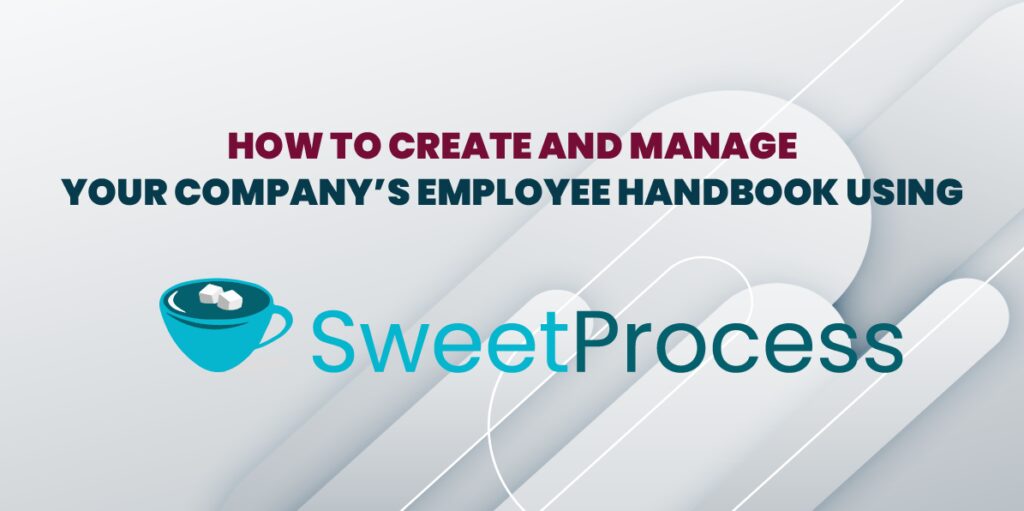
Creating an employee handbook can be a bit of a balancing act. You’ve got to make sure everything is clear and comprehensive but not overly complicated. Staying on top of legal requirements while keeping it friendly can be tricky. Updating it to match changes in policies and laws can take time, and you need to ensure it caters to all employees’ needs and backgrounds.
But you can take the edge of the most difficult bits by using a modern cloud-based process documentation software like SweetProcess. Our web app helps you get all your policies in one place and then distribute them to the people when needed. With robust employee handbook software, you can streamline the creation, management, and distribution of your handbook, ensuring compliance and easy updates for your entire team
Here’s how SweetProcess can help you create your employee handbook.
Creating a policy in SweetProcess is pretty simple and requires four steps.
Step 1: Log in to your SweetProcess account
Start by creating an account with SweetProcess. We offer a free 14-day trial, so there is no need for credit cards just yet. Once signed up, you can upload your existing policy/process data to SweetProcess as part of the onboarding process.
Step 2: Start writing your new policy

If you wish to create your policies using SweetProcess, you can do so using our web interface. Once you’re in, head to the dashboard and click the “Policies” tab, then hit the “Create Policy” button. Give your policy a title and select the appropriate team(s)/user groups it will apply to. Click on “Continue” to proceed.
Step 3: Write down the policy content
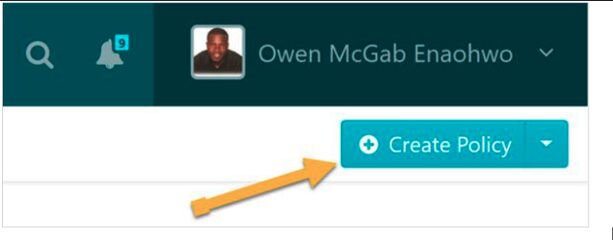
Begin adding the policy content by clicking “Add Step.” Assign a title to the step followed by the step description.

Assign the policy to the teams to which it will apply.
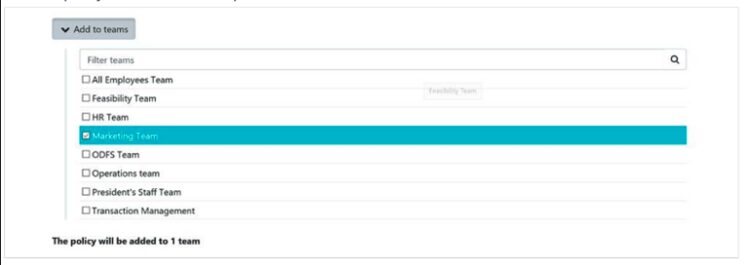
We also encourage you to use multimedia like images, videos, or gifs to enhance the documents.
Step 4: Review and publish
Once you’ve established your policy steps, review the content thoroughly. When you’re ready, select “Approve” at the top right to finalize and publish the policy.

All documents need to be approved before they go live. You can click the “Request Approval” button to send the document to the relevant manager for review. Once approval is granted, the policy is visible to the people it is assigned to.
How to Create a Company’s Policy in SweetProcess Using AI
SweetProcess also allows us to create workplace policy documents automatically using our own SweetAI writer. The tool simply needs your industry and keyword to start generating text.
To use SweetAI, follow until step two and create your policy document like you normally would. Next, enter the policy title and click on “Write with SweetAI.” Wait a couple of minutes until the text is generated.

Finally, go through the policy draft to ensure it matches your content goals. While SweetAI does a great job crafting policy and procedure documents, it’s best to edit and polish them before publishing.
How to Manage a Company’s Policy in SweetProcess
Managing policies in SweetProcess involves overseeing their lifecycle, including updates, revisions, and organizational alignment. Users select specific policies to edit and access features to modify content. Here’s an example:
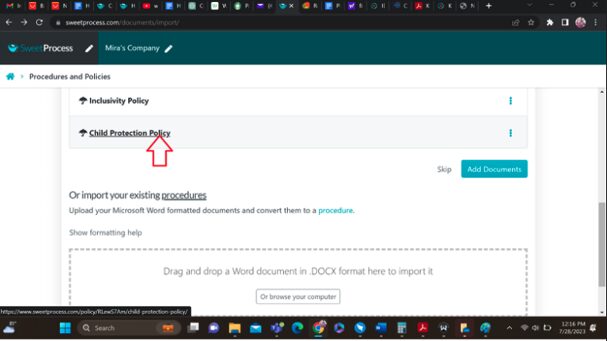
Next, hit the “Edit” button to make your changes.
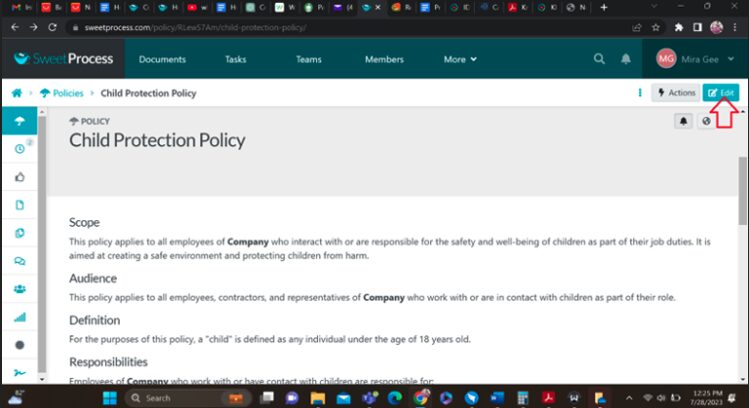
Additionally, the platform offers advanced functionalities like tagging, organizing policies into folders or teams, and exporting policies.
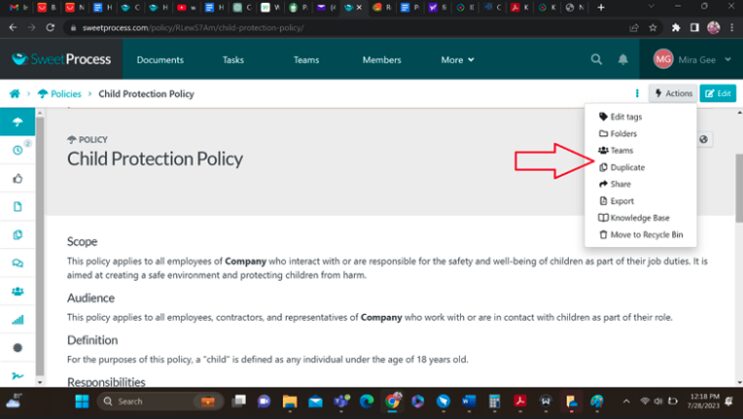
SweetProcess streamlines policy management, allowing users to efficiently maintain and update policies as needed. This ultimately supports a robust framework for organizational governance and compliance.
Managing policies with SweetProcess really is THAT easy! Sign up for free and see for yourself today.
6 Amazing Employee Handbook Examples You Can Copy
Finding the right tone and voice for your company’s employee handbook can be tough. Here are a few examples from some of the best, most inspiring handbooks worldwide.
Basecamp
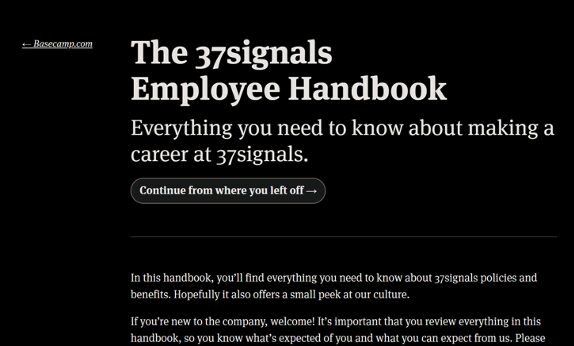
Basecamp was born out of a need most companies are familiar with. As firms grow, they often encounter operational challenges that seem insurmountable. That’s why 37Signals made the app since they needed a tool to help them deliver exceptional service without affecting growth. Besides having a great product, 37Signals also has an employee handbook that is as simple as it is effective.
Trello
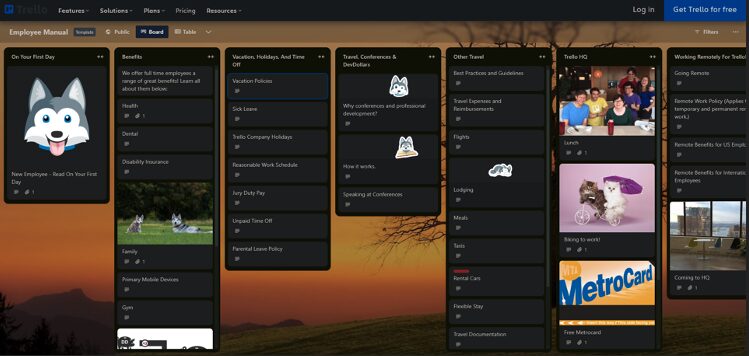
Trello took a rather innovative approach and used their product to create an online employee manual. Through the app’s card-based system, Trello’s employee manual uniquely introduces new hires to the company while acquainting them with its product. Each list within the Trello board corresponds to a handbook section, covering topics like employee benefits and travel. While most content is publicly accessible, sensitive workplace policies are stored on a private board. Humorous photos and concise bullet points maintain a light, engaging tone throughout.
Zappos
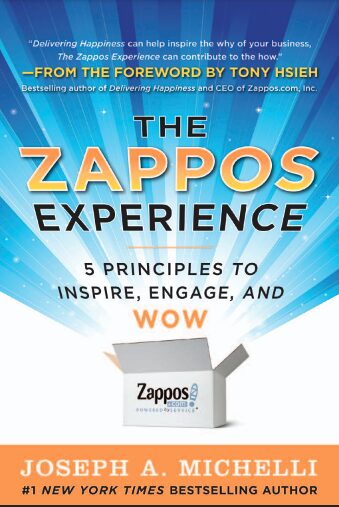
The online shoe and clothing retailer is well known for placing a huge emphasis on culture and well-being—so much so, that they even offer their new hires $3,000 to quit after their 4-week training, which is their way of saying they only want people who really want to be here. Their employee handbook is easily one of the most inspiring ones ever. Instead of telling employees what the company expects, it’s filled with their milestones, greatest accomplishments, and employees’ thoughts and opinions. Now THAT is how you land a good first impression!
Zoom
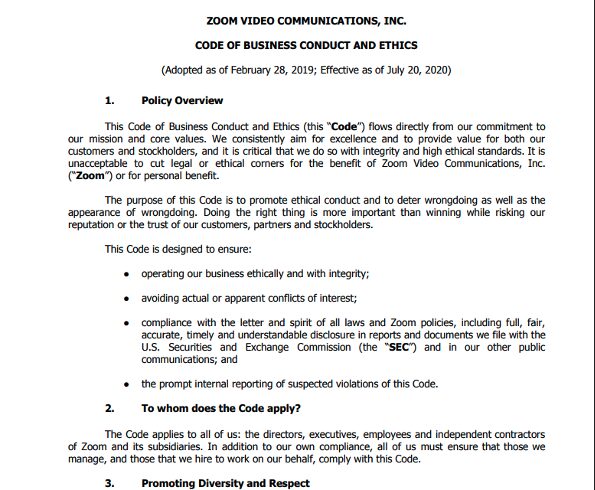
Zoom takes a more formal approach to writing an employee manual. Calling it their business code of conduct, the handbook outlines all the rules employees must follow while employed at Zoom. While not particularly thrilling, Zoom’s approach is straightforward enough to ensure nothing’s left to the imagination.
HubSpot
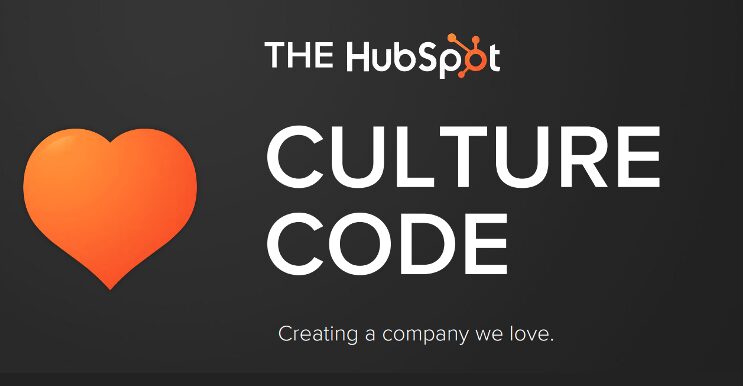
HubSpot calls its employee handbook its Culture Code. It even opens with the statement, “Customers are more easily attracted to a great product, great people are attracted to a great culture.” The book lists 10 codes that highlight HubSpot’s cultural priorities. The following pages elaborate on each point clearly. The handbook follows a minimalist design and even comes across as a slide deck more than a book.

Facebook’s employee handbook looks similar to HubSpot’s. It follows a simple design and focuses on the company’s goals and how the employee is expected to help them achieve them. Facebook has also found a great balance in its messaging, which is both inspiring and instructional.
With SweetProcess, your next employee handbook could outdo these! Sign up for our free 14-day trial and start today.
Benefits of an Employee Handbook in Your Company
Done right, an employee handbook can go way beyond just onboarding new hires with a set of dos and don’ts. Since much of what a company publishes is technical and formal in nature, the employee handbook can provide a casual way to get ideas across. Broadly speaking, there are five benefits to having an employee handbook.
Comply With the Industry’s Regulations
Most industries have a plethora of legal requirements to stick to. While a contract is the best place to ensure that new hires understand the legal underpinnings of their jobs, the employee handbook can help you summarize the more important rules better.
By clearly outlining workplace policies related to areas such as safety protocols, non-discrimination practices, and labor laws, the handbook helps mitigate the risk of regulatory violations and potential legal consequences.
For example, a manufacturing company may include safety guidelines mandated by Occupational Safety and Health Administration (OSHA) regulations in its handbook to ensure compliance.
Mitigate Conflict in the Workplace
Conflicts are inevitable in any workspace. Given their nature, they also need to be negotiated with tact. It’s also hard to instruct people on how to resolve conflicts in contracts or official documents since these are pretty black-and-white in their approach.
Conflicts, on the other hand, usually arise due to misunderstandings where no one is clearly at fault. This is also why the employee handbook is the perfect place to elaborate on some of the more subtle aspects of conflict resolution.
Clear and consistent policies outlined in the employee handbook help mitigate conflicts by providing a framework for resolving disputes. For instance, a harassment policy that outlines reporting procedures and disciplinary actions can address incidents of misconduct promptly, fostering a respectful work environment.
Welcome New Employees
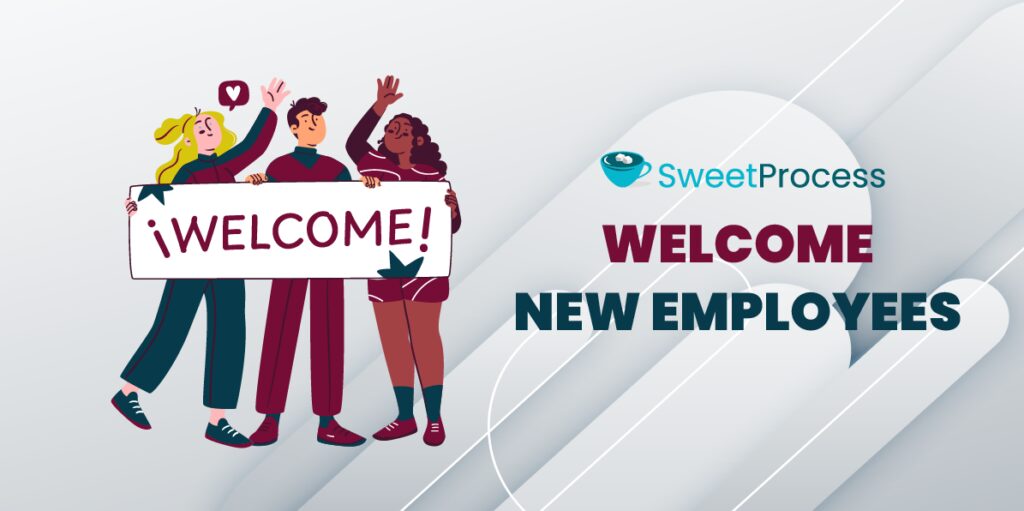
Employee handbooks play a crucial role in the process of welcoming new hires by setting the tone for the company culture through the welcome statement. This initial impression shapes employees’ perceptions and fosters a positive work environment.
The welcome statement is best written with a conversational tone to set it apart from the contractual stuff the new hires have to go through. It’s also important to keep the emphasis on company culture and positivity, which are key elements to ensure the welcome statement resonates with new employees and encourages engagement with the handbook.
Set Clear Expectations for Employees
Setting clear employee expectations is essential for the performance and productivity of your team members. The employee handbook communicates company policies, procedures, and performance standards, ensuring employees understand what is expected.
For instance, imagine an employee consistently exceeds their break time. In such cases, referring to the employee handbook clarifies break policies and the procedure for addressing excessive breaks.
Alternatively, what if the company policy requires strict adherence to specific software for tasks, but some employees prefer alternative tools? You could find a middle ground through designated software training sessions that help accommodate preferences while ensuring productivity standards.
Reduce Uncertainty

It’s almost impossible to develop policies and procedures that can address every problem. There are also plenty of gray areas that employees have to deal with, but that won’t be mentioned in the policy or process documents.
For example, what if an employee faces a situation where a colleague constantly undermines their work? Or if an employee encounters a customer who becomes verbally abusive during a service interaction?
Left unaddressed, such problems can quickly snowball into massive problems. While such issues may be discussed in the contract, they can also be mentioned and addressed in the employee handbook.
Employee Handbook Tips and Best Practices
Keep the Tone Positive, Professional, and Understandable
Ensure your handbook strikes a balance between professionalism and approachability. When outlining guidelines for dress code or conduct in the workplace, using clear and respectful language can help employees feel more comfortable and motivated to comply with the rules.
For instance, instead of using a strict and authoritarian tone like “employees must adhere to strict attendance policies,” which may come across as harsh and unwelcoming, you could rephrase it to “we value punctuality and reliability to ensure smooth operations.”
Similarly, instead of using intimidating language like “employees are required to adhere to the company’s dress code at all times,” you could write something like “We appreciate professionalism in attire to maintain a positive work environment.”
Avoid Legal Jargon or Confusing Terminology
Leave the legal stuff for the contract—the employee handbook is where you let the hair down and speak to your team members more casually. We recommend you use the barstool test to determine your tone here. The idea is to imagine explaining a decision or company policy to someone while in a casual setting like a bar. If you can’t explain it in simple, straightforward terms that anyone can understand, it may indicate that the decision or policy is overly complex or unclear.
So, instead of writing “The company prohibits discrimination and harassment in the workplace based on race, color, religion, gender, sexual orientation, age, or disability,” you could write “We don’t tolerate unfair treatment or bullying at work. That means nobody should be treated differently because of their race, religion, or who they like. We want everyone to feel respected and safe here.”
Keep a Digital Copy Readily Available to All Employees
A digital copy of your employee handbook may seem like a formality at first glance, but it provides various benefits. You can have a digital copy signed to ensure all employees have read and understood the handbook. Digital handbooks are also much more accessible than physical ones, not to mention impossible to misplace or lose.
Consider using a signable PDF and utilizing platforms like Google Drive or the company intranet. For example, employees can access the handbook through a shared folder on the company intranet site.
Include Contact Information for the Company Representative Available to Answer Questions
Provide employees with contact information such as email addresses and phone numbers for handbook queries so that employees know exactly who to reach out to for assistance. This ensures that employees have access to the information and support they need to understand and comply with company policies. Additionally, it demonstrates the company’s commitment to transparency and accessibility, fostering a culture of open communication and trust within the organization.
Designated contacts can include Human Resources (HR) personnel, department heads, or other relevant individuals who are knowledgeable about company policies and procedures. For example, listing the HR manager’s email and phone number prominently in the handbook makes it easy for employees to contact them directly with any questions they may have about HR-related matters.
Review the Employee Handbook Regularly
Regularly reviewing the employee handbook is essential to ensure that its policies and guidelines remain up-to-date, relevant, and compliant with current employment laws and company practices. By scheduling annual reviews or as needed, organizations can proactively identify any necessary updates or revisions to the handbook.
For example, if labor laws or regulations change, such as minimum wage requirements or anti-discrimination policies, these should be promptly reflected in the handbook. Similarly, if company procedures or policies change, such as the process for requesting time off or guidelines for remote work, these should also be incorporated into the handbook to keep employees informed.
Regular reviews also provide an opportunity to assess the effectiveness of existing policies and identify any areas for improvement. By asking for feedback from employees or conducting surveys, organizations can gather valuable insights into how well the handbook is understood and utilized in practice.
Communicate New Updates to the Employee Handbook with Team Members
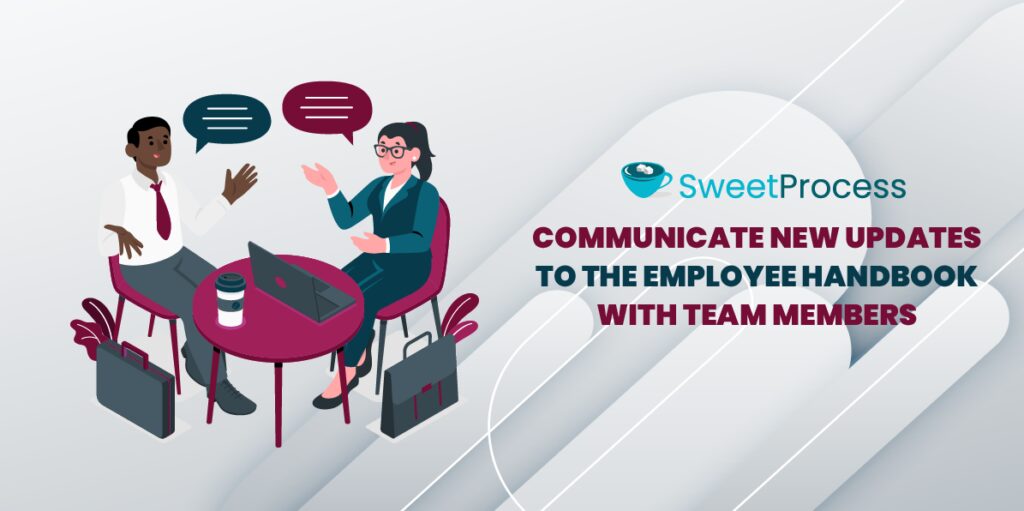
Communicating new updates to the employee handbook with team members is crucial for ensuring that employees are aware of any changes or additions to company policies and procedures. Prompt and clear communication helps to keep everyone informed and aligned with the latest guidelines.
Email notifications or team meetings are effective methods for disseminating information about handbook revisions or additions. For instance, HR can send an email to all employees outlining the updates and directing them to the revised sections of the handbook.
In addition to email notifications, holding team meetings or briefings can provide an opportunity to discuss the updates in more detail and address any questions or concerns that employees may have. By communicating new updates promptly and transparently, organizations demonstrate their commitment to keeping employees informed and engaged.
Worried you might have missed something? With SweetProcess, you’re always in control. Sign up for free and start your 14-day trial.
Free Employee Handbook Templates You Can Tweak and Use for Your Small Business
Why write an employee handbook from scratch when there are so many great examples to follow? Here are three examples you can steal from and/or get great ideas from.
Workable
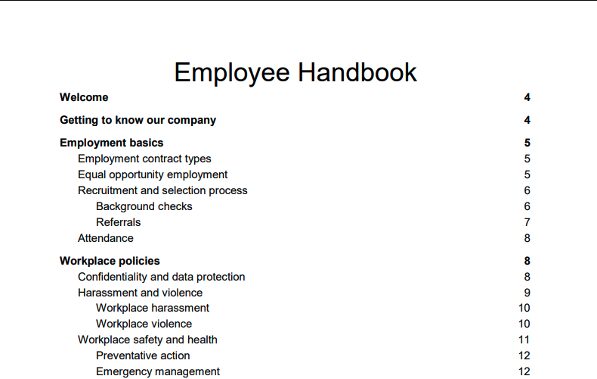
Workable is a popular cloud-based recruiting software platform used by businesses in a myriad of industries. The platform offers features for posting job openings, managing candidates, conducting interviews, and collaborating with team members throughout the hiring process. Suffice it to say that Workable knows a thing or two about managing workspaces, and their employee handbook reflects this prowess well. Check out their handbook template here.
ClickUp
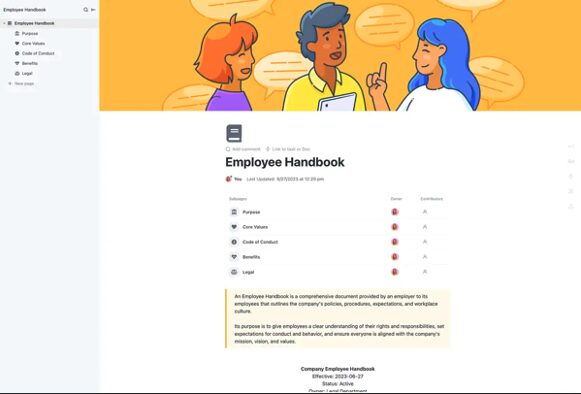
ClickUp’s template is a step above and comes with more multimedia options. In addition to offering an employee handbook template, you also get policies and procedures templates to keep all your data in one place. We also feel that ClickUp’s offering is more thorough and well thought out. However, since it’s ready out of the box, you may end up stuck in a fixed design philosophy with very little wiggle room.
Springworks
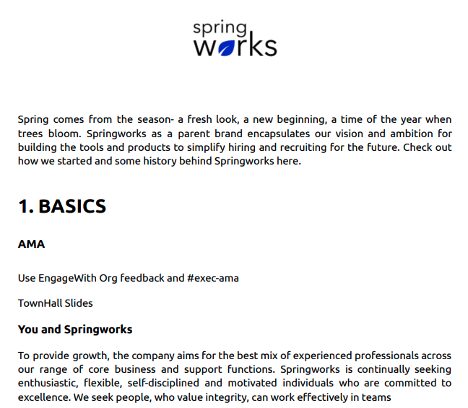
Springworks is an up-and-coming HR company that’s bringing blockchain machine learning to the field. They also have a great staff handbook template that is about as complete as you can get.
Create and Manage Your Company’s Employee Handbook Using SweetProcess
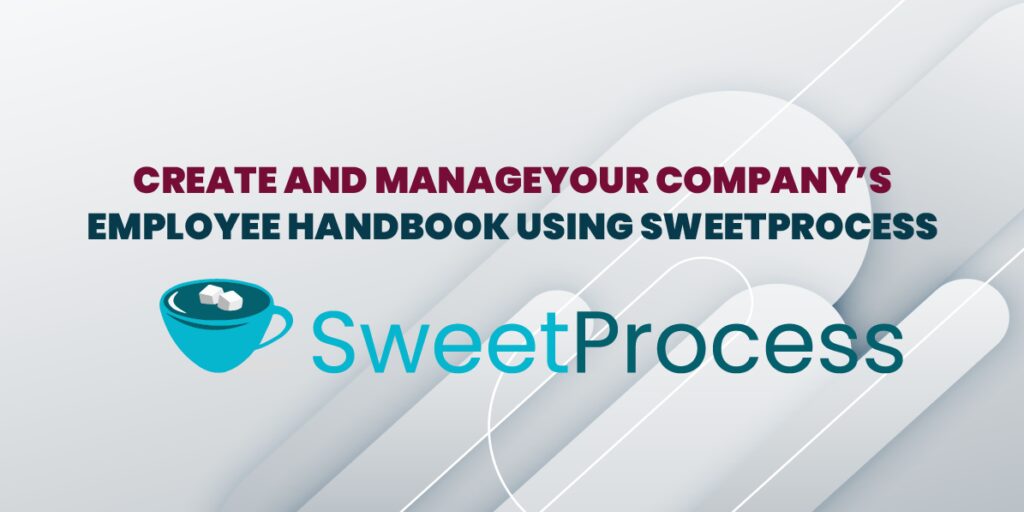
SweetProcess serves as a robust platform for compiling the essential components of an effective employee handbook. Through its intuitive interface, businesses can systematically document processes, procedures, and policies, ensuring comprehensive coverage of all pertinent information.
For instance, HR departments can outline onboarding procedures and codes of conduct and leave policies step-by-step within SweetProcess. Moreover, its visual process maps and clear instructions simplify complex procedures, enhancing employees’ comprehension.
By centralizing all handbook-related content in SweetProcess, businesses streamline the creation process and facilitate ongoing updates and revisions. Ultimately, SweetProcess empowers organizations to foster a culture of transparency, consistency, and compliance through their employee handbooks.
Ready to streamline your business processes and create clear, comprehensive documentation? Try out SweetProcess today and experience the difference firsthand.
Frequently Asked Questions (FAQs) About Employee Handbooks
What’s the difference between an employee handbook and a policy manual?
The primary difference lies in scope and detail. An employee handbook typically covers broader topics like company culture and values. A policy manual, on the other hand, outlines specific policies and procedures used in the company’s day-to-day operations.
All company members must strictly adhere to a policy manual. However, the company culture and value system are far more fluid and dynamic and open to interpretation. Therefore, it is imperative that managers make this distinction clear to all new hires during the onboarding process.
How often should an employee handbook be reviewed and updated?
A staff handbook should be reviewed annually, at minimum, and updated as needed to reflect changes in company policies, procedures, or legal requirements. Companies with global remote teams may need to update their handbooks more regularly. Neglecting regular reviews and updates may lead to discrepancies between actual practices and documented policies, potentially exposing the company to compliance issues or employee grievances.
How long is the average employee handbook?
The length of an employee handbook varies depending on the size and complexity of the organization, as well as the industry and legal requirements. However, it typically ranges from 20 to 50 pages. There is no fixed number that needs to be adhered to, though. In fact, it’s better if the handbook is as succinct and short as possible. We don’t want to over-inform people with things they don’t need, after all.
Are employers required to provide an employee handbook?
If we consider all your company policy, procedure, and process data as a content marketing strategy, then a staff handbook lies at the top of the sales funnel. It initiates the reader into the company’s culture and way of working. So, while there is no legal requirement for employers to provide an employee handbook, it is highly recommended as a best practice for promoting transparency, consistency, and compliance within the organization.
Do employees have to sign an employee handbook?
While employees are not legally required to sign an employee handbook, obtaining their acknowledgment of receipt and understanding is recommended. This helps demonstrate that employees have been informed of company policies and procedures, reducing the likelihood of disputes or claims of ignorance regarding their obligations and rights within the organization.

